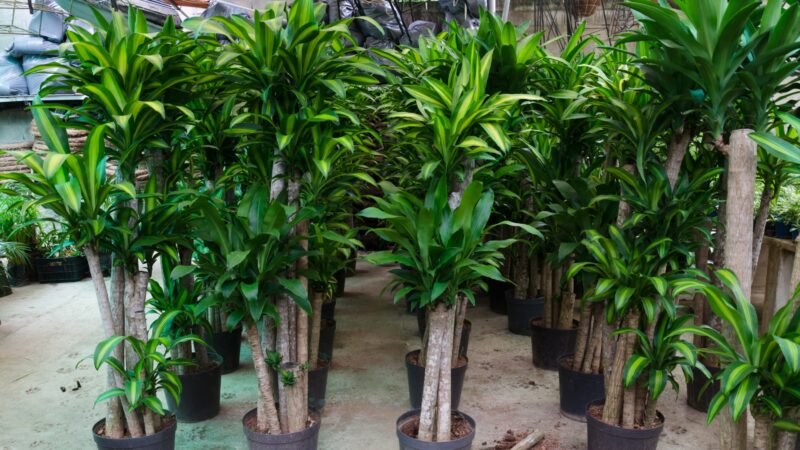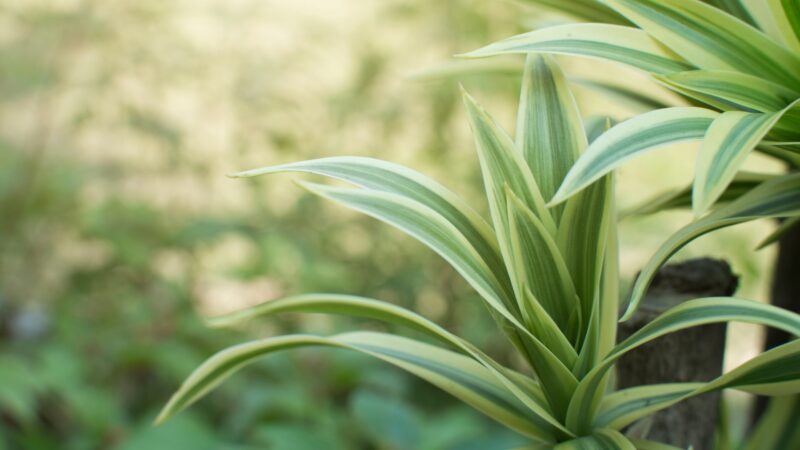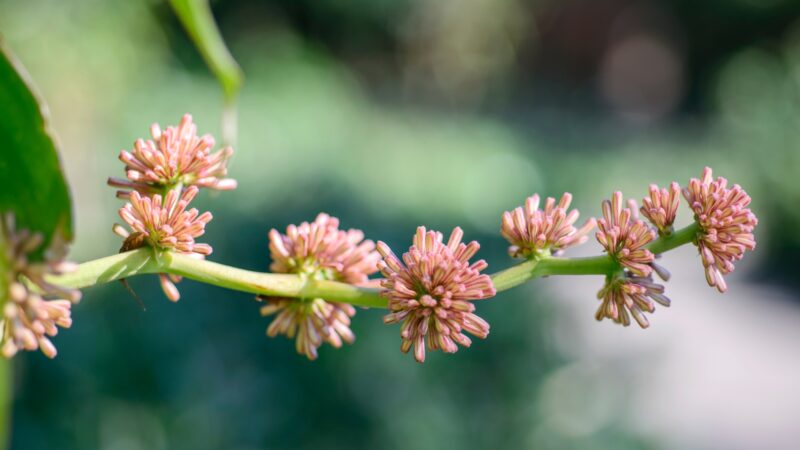The corn plant (Dracaena fragrans) is a popular houseplant known for its shiny leaves and its ability to remove any indoor toxins that are present in the air. Under the right care, it can produce multiple crowns and small clusters of fragrant, white flowers.
To take care of a corn plant, grow them in an organic potting mix and place them in a location where they can receive bright, indirect light. Use lukewarm, fluoride-free water to water weekly or every other week.
Mist its foliage regularly and maintain a 40% to 50% relative humidity and temperatures of 70°F to 80°F. Fertilize monthly during spring and summer.
This article provides you with everything you need to know about the corn plant, how to grow and maintain it, and other interesting information. Read further for more!
What Is a Corn Plant?

Corn Plant is a slow-growing, perennial shrub native to tropical Africa. It belongs to the Asparagus family and is commonly grown as a houseplant in the United States, particularly hardy to USDA Zones 10 to 11. This species and its cultivars are one of the most popular dracaena plants being commercially sold.
- Scientific Name and Common Names: Dracaena fragrans; Corn Plant, Dragon Tree
- Appearance: Resembles a corn plant due to its tall, unbranched stem. It also has lance-shaped or oval leaves, which can be emerald to gray-green in color, sometimes with stripes or spots of yellow or white, as well as white, fragrant flowers and round, fleshy fruits. It can reach up to 20 feet tall and spread up to 3 feet wide.
- Origin: Tropical Africa
- Indoor or Outdoor plant: Indoor
Where to Plant a Corn Plant?
Corn plants are usually grown indoors as large low-maintenance interiorscape, specimen, or container culture plants.
Can Corn Plants Live Outside?
Corn plants can live outside, specifically in USDA Hardiness Zones 10 to 11. These areas comprise the southern half of the US and the western coastal margins, characterized by temperatures between 30°F to 50°F.
When to Plant a Corn Plant?

They can be planted at any time of the season, but the best time would be after the dangers of the last frost have passed. In other words, early spring. If you plant any later, you would have to take great measures to keep your plant alive during the winter season.
How Fast Does Corn Plant Grow?
Corn plants are slow growers, with an average rate of 6 inches a year.
How to Grow Corn Plants From Seed?
Step 1: After purchasing corn plant seeds, soak them in room temperature water for 3 to 5 days to promote germination.
Step 2: Fill a container with a starting potting mix, then slightly moisten it. Make sure it is sufficiently wet but not waterlogged or saturated with water.
Step 3: Sprinkle the seeds on the surface of the potting mix. Then, cover them lightly.
Step 4: Place the container where the seeds can receive temperatures of 70°F to 80°F.
Step 5: Cover the container with clear plastic.
How to Take Care of a Corn Plant?
Lighting
Corn plants can thrive best in bright to moderate, indirect light, but they can also grow in low-light conditions. Avoid giving them direct sun as it can cause foliage burn, but make sure they are receiving sufficient levels of the curtain-filtered sun, or else their leaves will thin out. You can also use artificial light if there isn’t much sun in your area.
Water
Water using lukewarm, fluoride-free water once every one to two weeks but make sure to let the soil slightly dry in between waterings. Its soil should be kept moist but never waterlogged or soggy. Mist two to three times a week in the winter when the air in its surroundings is dry.
Temperature and Humidity
When planting indoors, corn plants can thrive in temperatures between 70°F to 80°F, with relative humidity between 40% to 50%. Since indoor humidity is generally way too low, regular misting of the plant’s foliage can help increase it.
Soil
Any commercial potting organic soil can work as long as it is well-draining but is kept sufficiently moist. Look out for potting mixes with a high permeability to air and water, good water-holding capacity and drainage, aeration, and fertility.
Avoid soils that have high amounts of perlite in them. Loam soils that are between a pH level of 6.0 to 6.5 are ideal.
Fertilizer
Apply liquid foliage plant fertilizer once a month, particularly during the spring and summer seasons. Time-release pellets may also be used.
Make sure the product you use does not contain any superphosphate, as it contains high amounts of fluorine, which may be toxic to the plant.
Potting and Repotting
Use any porous (unglazed ceramic, clay, or terracotta) and semi-porous (pressed fiber or wood) containers that have drainage holes and a saucer that can expel and catch, respectively, any excess water.
It also depends on your watering habits: if you tend to overwater, use a porous container and if you tend to underwater, choose a nonporous container.
Repot the plant when roots are growing through the drainage holes of its containers or when they grow outwards of the plant. Place it in a new, slightly larger container with fresh potting mix.
How to Propagate a Corn Plant?

Step 1: Corn plants are usually propagated by semi-hardwood cuttings, which are taken from partially mature wood of the current season’s growth.
Step 2: In the early morning, when the plant is fully turgid, use sharp pruning shears or a sterilized knife to select the cuttings from a healthy, disease-free plant. The cuttings should be 4 to 6 inches long.
Step 3: Remove any flowers and flower buds, as well as leaves from the lower one-third of the cutting.
Step 4: Treat the cuttings using root hormones to stimulate the growth of healthy roots. Tap excess hormone if you’re using a powdered formula.
Step 5: Insert the cuttings one-third to one-half of their entire length into a sterile and well-draining rooting medium, then water afterward. Ensure that the cuttings are pointed upwards.
Step 6: Cover the cuttings using plastic, then place them in a location where they can receive bright, indirect, or curtain-filtered sunlight.
How to Prune a Corn Plant?
Prune when the plant has become too tall or has overgrown stems. Do so in the winter to rejuvenate the plant’s growth and keep it at your desired height. Use pruning shears or other sharp, sterilized cutting tools.
Does a Corn Plant Have Flowers?

Corn plants produce showy but small, fragrant flowers that are red, pink, or white in color, have six petals, and are star-shaped. However, when grown as a houseplant, they rarely bloom.
When a Corn Plant Blooms?
Its blooming pattern is unpredictable, but the common time would be from late fall to early winter or late spring to early summer seasons. Corn plants that have not bloomed for 5 to 10 years may bloom again.
How to Get Corn Plants to Bloom?
Grow them under the right conditions—plenty of bright, indirect sunlight, well-draining and aerated soil, regular misting, temperatures of 70°F to 80°F, and 40% to 50% relative humidity.
How to Save a Dying Corn Plant?
Increase the plant’s humidity by regularly misting its foliage and then watering the soil once a week. Allow it to receive bright, indirect sunlight or provide artificial lighting if necessary. Cut any brown or dead leaves to stimulate the new growth of healthy leaves.
Frequently Asked Questions
Are Corn Plants Poisonous?
Corn plants are toxic and unpalatable to animals. They do not cause allergies or are toxic to humans, which means they are safe to grow around children, but ingestion should be heavily discouraged nonetheless.
Are Corn Plants Easy to Care For?
Corn plants are easy to care for, as long as you maintain it in the right environmental conditions and have enough patience to wait for it to grow and/or bloom.
Why Does My Corn Plant Get Yellow and Brown Leaves?
- Overwatering can cause yellowing leaves. The plant likes sufficiently moist soil but not to the point that it is waterlogged or saturated. This must be ensured by having drainage holes in the container you place the corn plant in and a saucer to catch and drain any excess water.
- Using water that contains fluoride and chlorine can also be another culprit since corn plants are highly sensitive to these chemicals. Use filtered, rain, distilled, or tap water that has been sat out overnight.
- Dry soil caused by low humidity can make leaves droop and turn brown on their edges. If left untreated, the leaves can shrivel up. This is why regular misting on the plant’s foliage is important. You can also use a pebble tray or humidifier.
- Pests such as spider mites, mealybugs, and scales can also cause yellowing leaflets and fronds.
List of Sources
Dracaena Fragrans – https://plants.ces.ncsu.edu/plants/dracaena-fragrans/
Dracaena – https://hgic.clemson.edu/factsheet/dracaena/
Lighting Indoor Houseplants – https://extension.missouri.edu/publications/g6515